Vegetable Khichdi is the ultimate Indian comfort food — warm, filling, nutritious, and incredibly soothing for the stomach. When served hot with a bowl of fresh curd (dahi) and crispy papad on the side, it transforms into a wholesome and satisfying meal. It’s a favorite choice for days when you’re feeling under the weather, too tired to cook, or just in the mood for something light, soothing, and full of flavor.

This masala Vegetable Khichdi variation combines split yellow moong dal and green moong dal (with husk), along with broken rice (also known as rice rava or daliya). The use of both dals gives a perfect balance of smooth and slightly textured mouthfeel. You can customize the lentils based on what you have on hand—use only yellow moong dal for a softer, lighter khichdi or substitute with toor dal (arhar) for a heartier taste.
When it comes to consistency, I prefer a slightly mushy, porridge-like texture, which is achieved by adding a little extra water and cooking it thoroughly. However, if you prefer a more grainy texture where each grain holds its shape, simply reduce the water slightly and cut back on the cooking time.
This Vegetable Khichdi recipe includes a colorful mix of vegetables such as potatoes, carrots, green peas, capsicum, along with onions and tomatoes for added flavor and nutrition. You’re free to toss in any other vegetables you enjoy—like beans, cauliflower, spinach, or zucchini—making it a great clean-out-the-fridge meal.
What makes this Vegetable Khichdi even better is its simplicity. It’s a true one-pot meal—perfect for busy weeknights, quick dinners, or even light lunches. Despite being minimal in ingredients and effort, it’s big on comfort and flavor.
Khichdi is traditionally prepared using ghee, which imparts a rich, buttery flavor and a comforting aroma to the dish. For a lighter version, I’ve used oil instead, and it still turns out delicious. If you’re craving that traditional flavor, feel free to cook it in ghee or use a combination of oil and ghee. You can even just drizzle a spoonful of ghee on top right before serving to enhance the flavor and richness.
This easy Vegetable Khichdi is gluten-free, can be made vegan by skipping ghee, and is perfect for all age groups. Pair it with curd, pickle, roasted papad, or even a dollop of butter for a soul-satisfying meal any day of the week.
Ingredients For Vegetable Khichdi:
- ½ cup short-grain rice or broken rice (like daliya or rice rava): Rinsed thoroughly and soaked for 15–20 minutes
- ¼ cup yellow moong dal (split and skinless): Adds a creamy texture and light flavor
- ¼ cup chilkewali moong dal (green moong dal with skin): Gives earthiness and extra nutrition
- ½-inch fresh ginger: Peeled and finely grated or mashed to release its aromatic juices
- 2 garlic cloves: Finely chopped or crushed
- 1 green chili: Slit or chopped (adjust to taste)
- 3 tablespoons oil: Or use a mix of oil and ghee for richer flavor
- ½ teaspoon mustard seeds: For tempering
- ½ teaspoon cumin seeds: Adds a warm, nutty note
- 2 dried red chilies: Broken into pieces
- ½ cup finely chopped red onion: Sautéed until translucent
- ¼ cup chopped ripe tomato: Adds tang and body to the masala
- ¼ cup diced carrots: For natural sweetness and color
- 2 cup green peas: Fresh or frozen
- ¼ cup chopped capsicum (green bell pepper): For crunch and flavor
- ¼ cup cubed potatoes: Peeled and cut into small pieces
- Salt as needed: Adjust according to your taste preference and dietary needs.
- ½ teaspoon turmeric powder: Imparts a golden hue and offers anti-inflammatory benefits.
- 1 teaspoon coriander powder: Lends a gentle citrusy warmth and earthy depth.
- ½ teaspoon cumin powder: Adds a warm, nutty flavor that enhances the savory profile.
- 1½ teaspoons red chili powder: Gives a balanced heat to liven up the dish.
- ½ teaspoon garam masala: Stirred in at the end for a touch of warmth and complex aroma.
- 2½ cups water: Adjust to achieve your desired consistency, whether thick or porridge-like.
Step By Step Instructions:
1) Combine grains and lentils:
Add the broken rice (or any preferred short-grain variety) to a mixing bowl along with split yellow moong dal (skinless) and green moong dal (with skin). This blend gives the khichdi a perfect balance of texture, taste, and nutrition.
2) Rinse thoroughly:
Rinse the rice and dal mixture 2–3 times using clean water. You can also rinse it well under cold running water to eliminate excess starch and any surface impurities. This helps remove any dirt, dust, and extra starch, ensuring a non-sticky, clean base.
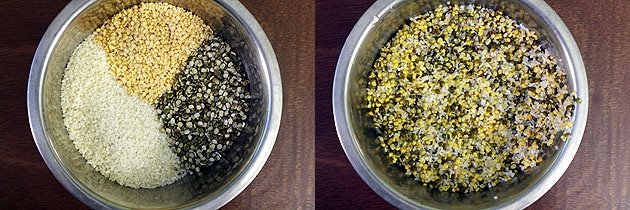
3) Prepare the flavor base:
In a mortar and pestle, add roughly chopped fresh ginger, garlic cloves, and green chilies. These form the aromatic base of your khichdi.
4) Crush to release flavors:
Coarsely crush the mixture to release its juices and essential oils. While ginger-garlic paste and chopped chilies are alternatives, freshly crushed ingredients bring a more robust and authentic flavor.
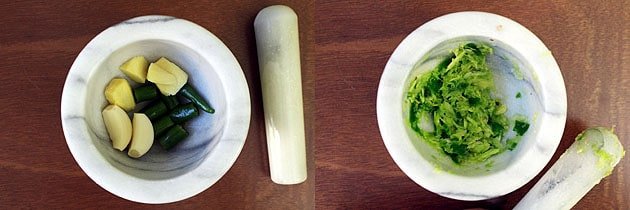
5) Heat the oil and temper spices:
Place a pressure cooker on medium heat and pour in the oil or ghee for extra richness. Once hot, add mustard seeds and let them crackle, signaling they’re ready.
6) Add dry spices:
Immediately add cumin seeds, followed by dried red chilies. Sauté for a few seconds to let their flavors infuse into the oil. Be careful not to burn them.
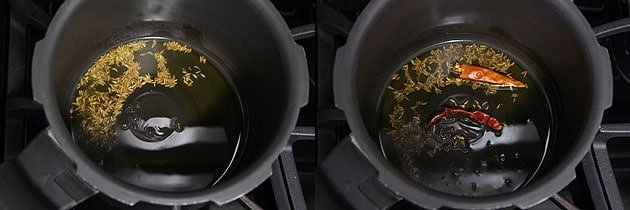
7) Add onions and aromatics:
Now toss in finely chopped onions along with the crushed ginger, garlic, and green chili mixture. Stir well to mix everything evenly.
8) Sauté till golden:
Cook the mixture, stirring occasionally, until the onions turn soft, translucent, and begin to turn light golden. This forms the flavorful base of the khichdi.
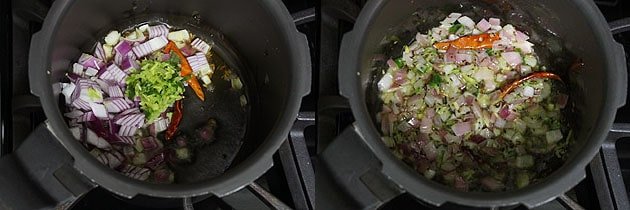
9) Add vegetables:
Now add all your chopped vegetables — such as tomatoes, potatoes, green peas, carrots, and capsicum. Feel free to include seasonal veggies for variety.
10) Combine and cook:
Mix the vegetables thoroughly with the sautéed onion and spice mixture. Cook for 2–3 minutes to let the vegetables absorb the base flavors.
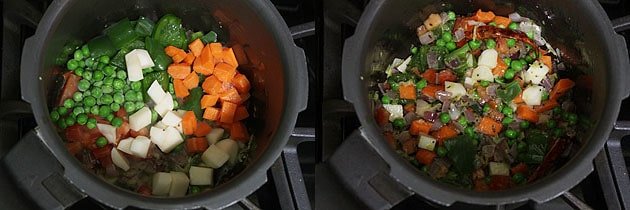
11) Add powdered spices:
Add salt to taste, turmeric powder for its vibrant color and health benefits, red chili powder to bring in a touch of heat, coriander powder for its subtle citrusy notes, cumin powder to enhance the earthy depth, and finish with garam masala for a warm, aromatic finish.
12) Cook spices briefly:
Stir everything well and let it sauté for a minute, allowing the spices to release their aroma and coat the veggies, enhancing the overall flavor.
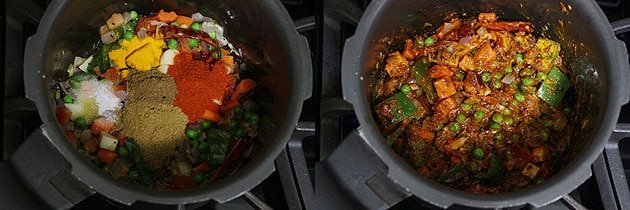
13) Add rinsed rice and dal:
Now add the rinsed rice and lentil mixture to the pressure cooker. Gently stir to combine it with the sautéed spices and vegetables, ensuring everything is evenly coated for a balanced, flavorful base. This will now absorb all the delicious base flavors you’ve built so far.
14) Stir everything together:
Gently mix the rice, lentils, and vegetables so they are evenly distributed. This helps everything cook evenly and allows the flavors to meld beautifully into each grain and lentil.
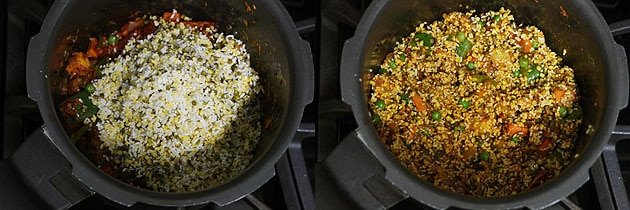
15) Add water:
Pour in 2½ cups of water (or adjust to your preferred consistency — use more for a softer, porridge-like texture). Stir well.
16) Pressure cook:
Close the pressure cooker with its lid and securely attach the whistle (weight) to ensure proper pressure buildup during cooking. Cook over medium heat for 3 whistles. This allows the dal, rice, and vegetables to cook perfectly while retaining flavor.
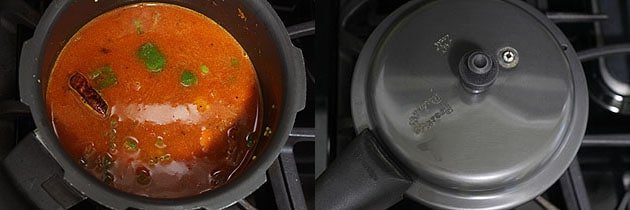
17) Let pressure release naturally:
Turn off the heat and allow the pressure to release on its own naturally. Avoid forcing it open, as this gentle release helps the flavors develop and ensures the khichdi retains its soft, comforting texture. Don’t force open the lid. This resting period helps the flavors settle and prevents splattering.
18) Fluff and serve:
Once the pressure has fully released naturally, carefully open the lid of the pressure cooker. Gently stir the khichdi with a spatula to mix and fluff it up evenly without mashing the grains. Serve it hot or warm, drizzled with a spoonful of ghee on top for added richness. For a complete and satisfying meal, pair it with chilled curd, a tangy pickle, or crisp papad on the side—perfect comfort food for any day.
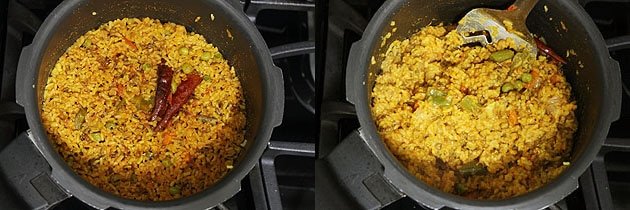
Expert Tips for Perfect Vegetable Khichdi:
- Rice & Dal Ratio: Use a 1:1 ratio of rice to dal for a well-balanced texture. Broken rice works beautifully for this rustic dish, but feel free to use any short-grain rice like sona masoori or gobindobhog.
- Soaking for Even Cooking: Soaking the rice and dals for 15–20 minutes before cooking can help them cook faster and more uniformly, resulting in a softer khichdi.
- Spice Control: Adjust red chili powder and green chilies based on your spice tolerance. If serving to kids or elders, reduce the spice and balance with a pinch of sugar.
- Vegetables: Add seasonal or leftover vegetables like beans, bottle gourd, cauliflower, or even spinach to make it more nutritious. Just chop them evenly so they cook at the same rate.
- Control the Texture: For a softer, porridge-style khichdi, add 3 to 3½ cups of water while cooking. If you like it with more distinct grains and a slightly drier consistency, use around 2½ cups of water instead. Adjust the quantity based on your personal texture preference.
- Ghee Finish: Even if cooked in oil, a final drizzle of ghee enhances the flavor manifold. For a vegan version, skip the ghee or use plant-based butter.
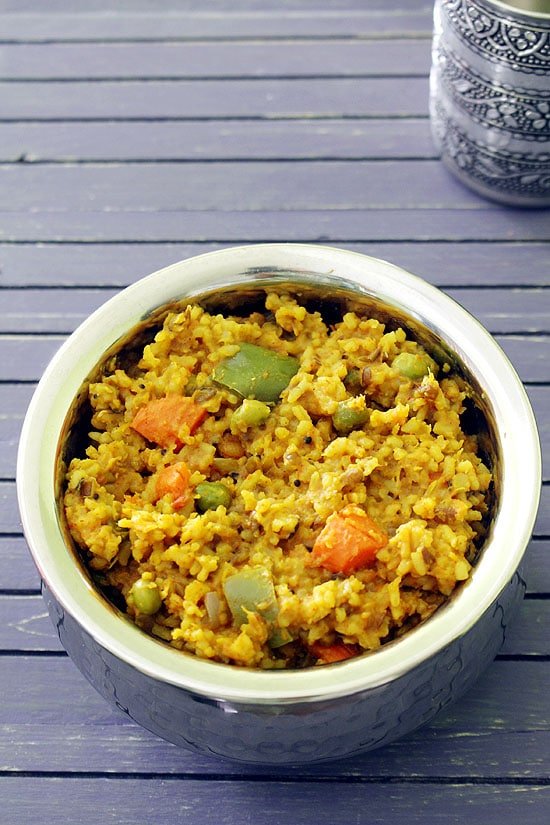
Serving Suggestions For Vegetable Khichdi:
Vegetable Khichdi is a wholesome, one-pot meal that’s satisfying on its own, but pairing it with a few accompaniments elevates the entire experience:
- Curd or Raita: A bowl of chilled plain curd or cucumber raita adds a cooling contrast to the warm, spiced khichdi.
- Pickle: A spoonful of lemon or mango pickle brings tangy intensity that complements the earthy flavors.
- Papad: Roasted or fried papad adds the much-needed crunch and completes the traditional Indian thali vibe.
- Fried Green Chilies or Onion Rings: For spice lovers, fried green chilies or crisp onion rings can be served on the side.
